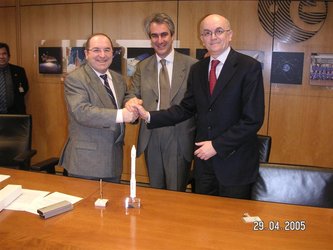Vega's second stage motor roars to life
ESA PR 21-2006. ESA’s Vega small satellite launch vehicle has made a new step toward its maiden flight, late next year, with the success of the first firing test on its second stage motor, the Zefiro 23.
The static firing was performed today, 26 June, at the Italian Ministry of Defence test centre in Salto di Quirra, Sardinia. The 7.5m tall, 2m diameter motor, featuring a carbon epoxy filament wound casing, delivered more than 100 metric tons of thrust (1,070 kN), burning some 24 metric tons of solid propellant in 75 seconds.
Numerous data were gathered during the test and are now under analysis to improve technical knowledge of the motor’s behaviour and refine the launcher’s future performance. Also tested during the firing were various subsystems, including a thrust vector control system that will steer the motor’s nozzle to provide flight control. After this success, the motor will proceed with its critical design review, at which stage its technical characteristics will be finalised.

Built by Avio in Colleferro, near Rome, the Zefiro 23 motor will be the basis for the second stage of ESA’s Vega launcher. The first firing test with the third stage motor – the Zefiro 9 – was performed in December 2005. Conducted on behalf of ESA’s Vega development programme, these two firing tests followed three static firings of the Zefiro 16 demonstrator in 1998, 1999 and 2000. Both the Zefiro 23 and Zefiro 9 will undergo an additional ground firing test each to complete their development and qualification.
“The Zefiro 23 is one of the largest composite casing solid rocket motors ever test fired in Western Europe,” noted Antonio Fabrizi, ESA’s director of launchers, “but it will be dwarfed shortly, when we will fire Vega’s first stage motor, the P80, with its 88 tons of propellant, in Kourou, French Guiana, in November.”
“With this new motor firing, the Vega programme has passed another milestone in good time,” continued Fabrizi, “and I praise our industrial team as well as our partner the Italian Space Agency, for this achievement. Now let’s proceed and make sure we will be able to meet our schedule for the next phases.”
The first Vega flight is currently set for the end of 2007 from Europe’s Spaceport in French Guiana.

Under development since 1998 with the support of seven ESA Member States (Italy, France, Belgium, Switzerland, Spain, the Netherlands and Sweden), ESA’s Vega small satellite launcher is an all-solid three-stage vehicle with a liquid-fuelled injection module. ELV SpA, a joint venture of Avio and ASI, the Italian Space Agency, was delegated the responsibility for Vega development. CNES, the French space agency, holds similar responsibility for the P80 first stage.
Vega is designed to loft single or multiple payloads to orbits up to 1,500 km in altitude. Its baseline payload capability is about 1,500 kg to a circular 700-km high sun-synchronous orbit but it can also loft satellites from 300 kg to more than 2 metric tonnes, as well as piggyback microsatellites. This range of performance covers the needs for multiple applications in the fields of remote sensing, environmental monitoring, Earth science, space science, fundamental science and research and technology for future space applications and systems. Once qualified, Vega will be marketed and operated by Arianespace, as a complement to Ariane 5 and Soyuz, and will address the small satellite launch market.
For further information, please contact:
ESA Media Relations Division
Phone + 33 1 53 69 71 55 – Fax: +33 1 53 69 7690















 Germany
Germany
 Austria
Austria
 Belgium
Belgium
 Denmark
Denmark
 Spain
Spain
 Estonia
Estonia
 Finland
Finland
 France
France
 Greece
Greece
 Hungary
Hungary
 Ireland
Ireland
 Italy
Italy
 Luxembourg
Luxembourg
 Norway
Norway
 The Netherlands
The Netherlands
 Poland
Poland
 Portugal
Portugal
 Czechia
Czechia
 Romania
Romania
 United Kingdom
United Kingdom
 Slovenia
Slovenia
 Sweden
Sweden
 Switzerland
Switzerland

































